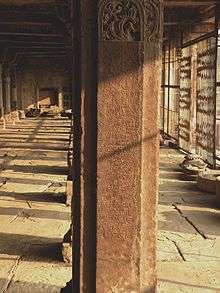Naravarman
| Naravarman | |
|---|---|
| Nirvana-Narayana | |
 Pillar in the Bijamaṇḍal, Vidisha with an inscription of Naravarman | |
| King of Malwa | |
| Reign | c. 1094 – c. 1130 CE |
| Predecessor | Lakshmadeva |
| Successor | Yashovarman |
| Dynasty | Paramara |
Naravarman (reigned c. 1094-1133 CE), also known as Naravarma-deva, was an Indian king from the Paramara dynasty, who ruled in the Malwa region of central India. The Paramara power greatly declined during his reign, as a result of multiple military defeats.
Early life
Naravarman succeeded his elder brother Lakshmadeva as the Paramara king.[1] His inscriptions have been found at Amera near Udaipur (1093-1095 CE), Dewas (1094 CE), Bhojpur (1100-1101 CE), Nagpur (1104-05 CE), and Vidisha (undated). One more inscription was issued at Kadambapadraka (1110 CE), and was found in the possession of a resident of Bombay. H. V. Trivedi identifies Kadambapadraka with present-day Kamlikhedi (or Kamalyakhedi) village near Ujjain.[2]
Military career
Naravarman lost some of his eastern territories to the Chandelas of Jejakabhukti. He also suffered a defeat against the Chahamanas of Shakambhari. The Chahamana king Ajaya II captured his general Sollana. Ajaya also killed three noted warriors named Chachiga, Sindhula and Yashoraja, who appear to have been Naravarman's subordinates.[3][4] The Ingnoda inscription of 1133-34 CE indicates that there was an independent kingdom north-east of Ujjain. Its ruler Vijayapala bore the title Maharajadhiraja-Paramesvara. This indicates that the Paramaras had lost control of this area by the end of Naravarman's reign.[5]
Jayasimha Siddharaja, the Solanki king of Gujarat, also defeated Naravarman. In this campaign, Siddharaja was supported by his feudatories, the Chahamanas of Naddula.[4] According to the Solanki chronicles written by Someshvara, Jinamandanagani and Jayasimha Suri, Naravarman was imprisoned by the Solanki king. However, other chroniclers such as Hemachandra, Arisimha, and Merutunga state that the prisoner was Naravarman's successor Yashovarman.[6] The Chaulukya-Paramara war probably began during the reign of Naravarman, and ended during Yashovarman's reign.[7]
Naravarman adopted the title "Nirvana-Narayana". An undated fragmentary inscription from the Malwa claims that a king called Nirvana-Narayana conquered territories as far as Himalayas in the north, Malayachala in the south and Dvarika in the west. However, this seems to be a conventional poetic description, and has no historical basis.[8]
Cultural activities
Naravarman was a poet, and composed hymns to various deities and eulogies of his ancestors. The Nagpur Prashasti may have been composed by him.[9] He restored the Mahakala temple of Ujjain, and composed a hymn in the deity's honour.[10] Gold (5.2 g), silver (2.9 g) and copper coins issued by Naravarman have been found in Indore.[11][12]
According to the Rajatarangini, Naravarman gave asylum to the Kashmiri prince Bhikshachara, who had escaped a revolt. He brought up Bhikshachara like his own son, and trained him in use of arms and sciences.[13]
References
- ↑ Jain 1972, p. 359.
- ↑ Trivedi 1991, pp. 114-120.
- ↑ Dasharatha Sharma 1959, p. 39.
- 1 2 Jain 1972, p. 357-358.
- ↑ Bhatia 1970, p. 115.
- ↑ Bhatia 1970, p. 122.
- ↑ Asoke Kumar Majumdar 1956, p. 75.
- ↑ Jain 1972, p. 360.
- ↑ Pollock 2003, p. 178.
- ↑ Pollock 2003, p. 177.
- ↑ Misra 2003, p. 21.
- ↑ Roy 1980, p. 66.
- ↑ Stein 1989, p. 20.
Bibliography
- Asoke Kumar Majumdar (1956). Chaulukyas of Gujarat. Bharatiya Vidya Bhavan. OCLC 4413150.
- Bhatia, Pratipal (1970). The Paramāras, c. 800-1305 A.D. Munshiram Manoharlal.
- Dasharatha Sharma (1959). Early Chauhān Dynasties. S. Chand / Motilal Banarsidass. ISBN 9780842606189.
- Jain, Kailash Chand (1972). Malwa Through the Ages, from the Earliest Times to 1305 A.D. Motilal Banarsidass. ISBN 978-81-208-0824-9.
- Misra, Om Prakash (2003). Archaeological Excavations in Central India: Madhya Pradesh and Chhattisgarh. Mittal Publications. ISBN 978-81-7099-874-7.
- Roy, P. C. (1980). The Coinage of Northern India. Abhinav. ISBN 9788170171225.
- Pollock, Sheldon (2003). The Language of the Gods in the World of Men: Sanskrit, Culture, and Power in Premodern India. University of California Press. ISBN 0-5202-4500-8.
- Stein, Marc Aurel (1989). Kalhana's Rajatarangini: a chronicle of the kings of Kasmir. 2. Motilal Banarsidass. ISBN 978-81-208-0370-1.
- Trivedi, Harihar Vitthal (1991). Inscriptions of the Paramāras, Chandēllas, Kachchapaghātas, and two minor dynasties. Archaeological Survey of India.